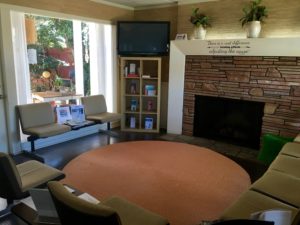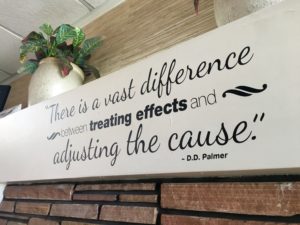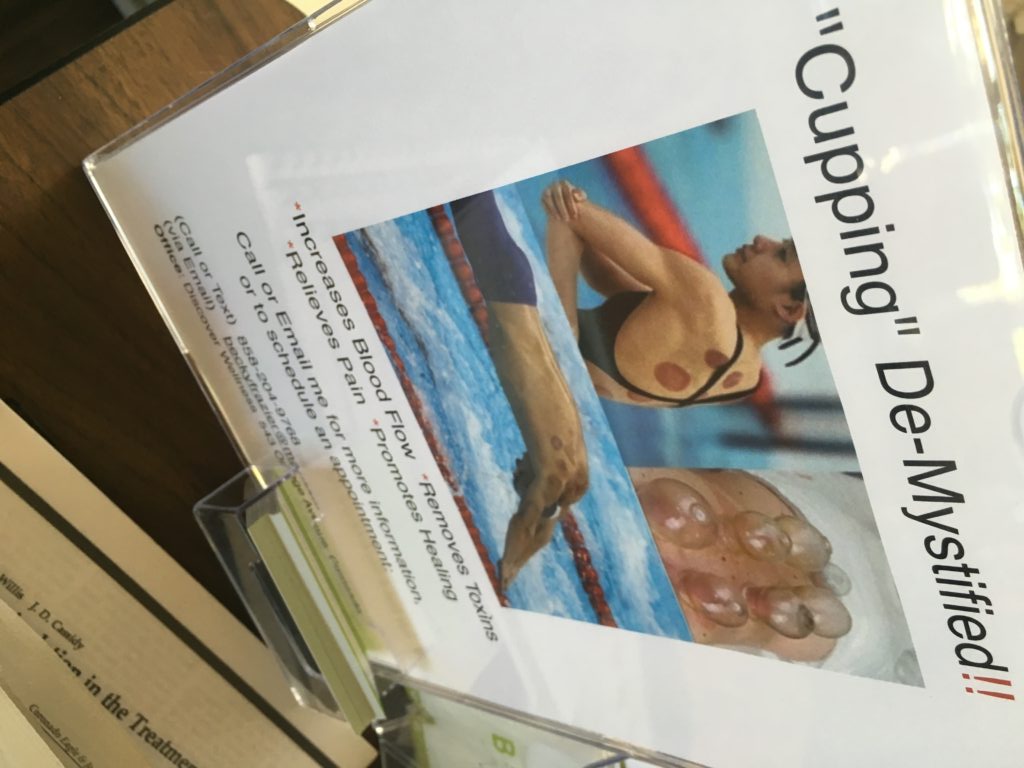
If you watched the 2016 Summer Olympics, you most likely noticed many athletes were sporting circular discolorations all over their bodies. What many people assumed were bruises were actually the result of “cupping,” an ancient therapy that has been primarily used in Asian and Middle Eastern countries for centuries.
So if you have an inquiring mind like I do, you’ll understand why I wanted to know everything there is to know about the therapeutic practice. I decided to enlist the help of a licensed professional and local Coronado resident, Becky Frazier.
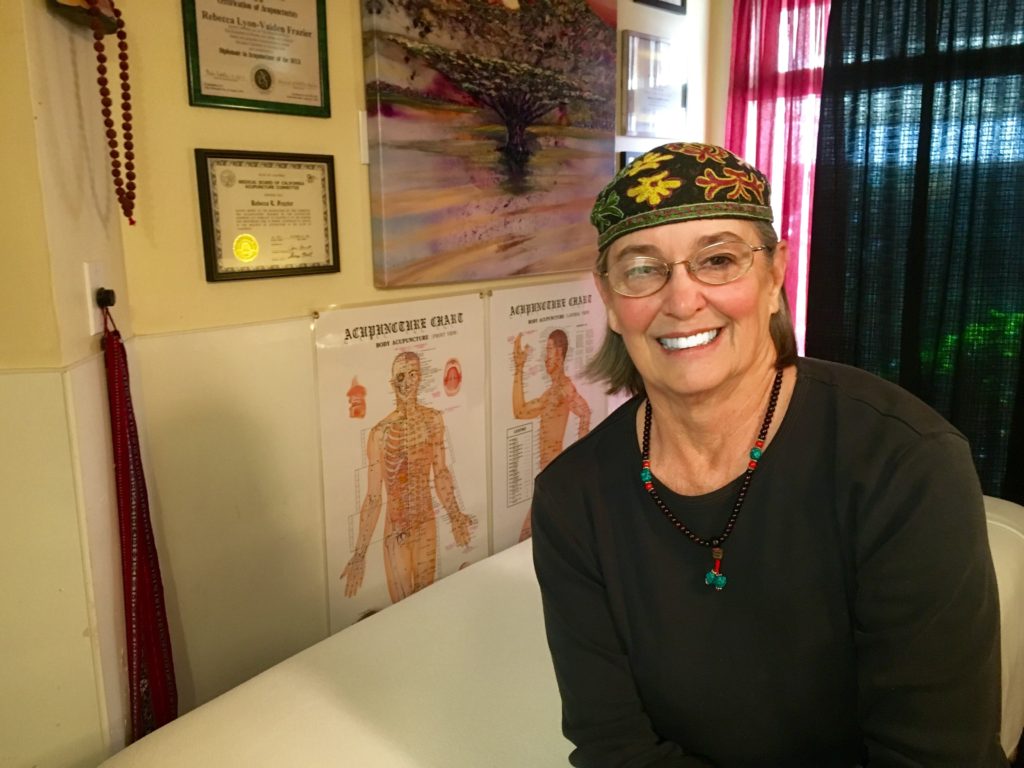
Meet National Board Certified and Licensed Acupuncturist Becky Frazier. Becky has been doing cupping for 26 years. “It’s a medical therapy. It’s not a fad,” says Becky.
Becky explains, “cupping is an ancient therapy where negative pressure (a vacuum) is created inside cups that are then applied to the skin. The cupping suction from the negative pressure inside the cup can be created by introducing either a fire into the cup or by manually using a pump to remove the air from inside the cup. This negative pressure forces the oxygen-rich blood to move towards the cup, thus saturating the tissues with fresh blood and promoting the healing process.” The cups used today have evolved greatly over the years. Now manufacturers mill traditional glass, soft silicone, and plastic pump cups.
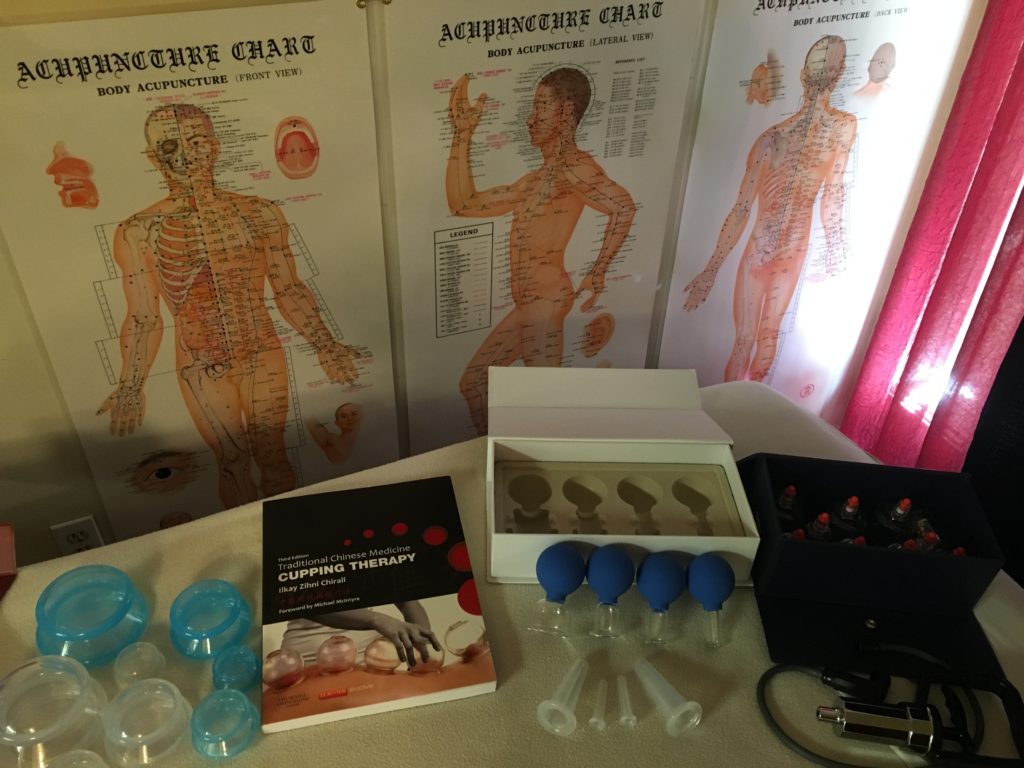
“I was first introduced to cupping in 1990 when I was a student at Pacific College of Oriental Medicine, here in San Diego. As students, we were taught the art of cupping as it’s part of the required training for every licensed acupuncturist.”
Becky welcomed me into her private practice, an office which is located in the Discover Wellness building at 543 Orange Avenue in Coronado.
Obviously, I was nervous about having cupping done. After all, I didn’t want to look like I had giant pepperonis plastered all over my body, or have my neighbors think I had been involved in a brawl. But since I’ve been suffering from severe back pain, which I’ll attribute to the sack of sugar I carry around daily (aka my daughter), I thought I would put all fear aside and give this treatment a go.
When Becky opened the door to her office, the fragrance of sandalwood immediately overtook my senses and instantly I found myself breathing deeply. All of the tension and anxiety I had bottled up was quickly dissipating.
I positioned myself on the wooden chair in the corner, wide-eyed and unsure of what to expect. Becky assured me there was nothing to be afraid of and began asking me about my medical history. As a new mom and a person who has had run-ins with medical complications in the past, I divulged every tidbit of information I could. Some may have called it a therapy session, but I call it being incredibly thorough with the medical intake form. As I was explaining about my pregnancy complications and postpartum recovery, it’s as if you could see Becky trying to put all of the pieces of my crazy and jumbled puzzle together. She was incredibly attentive, thorough, and responsive. She didn’t miss a beat.
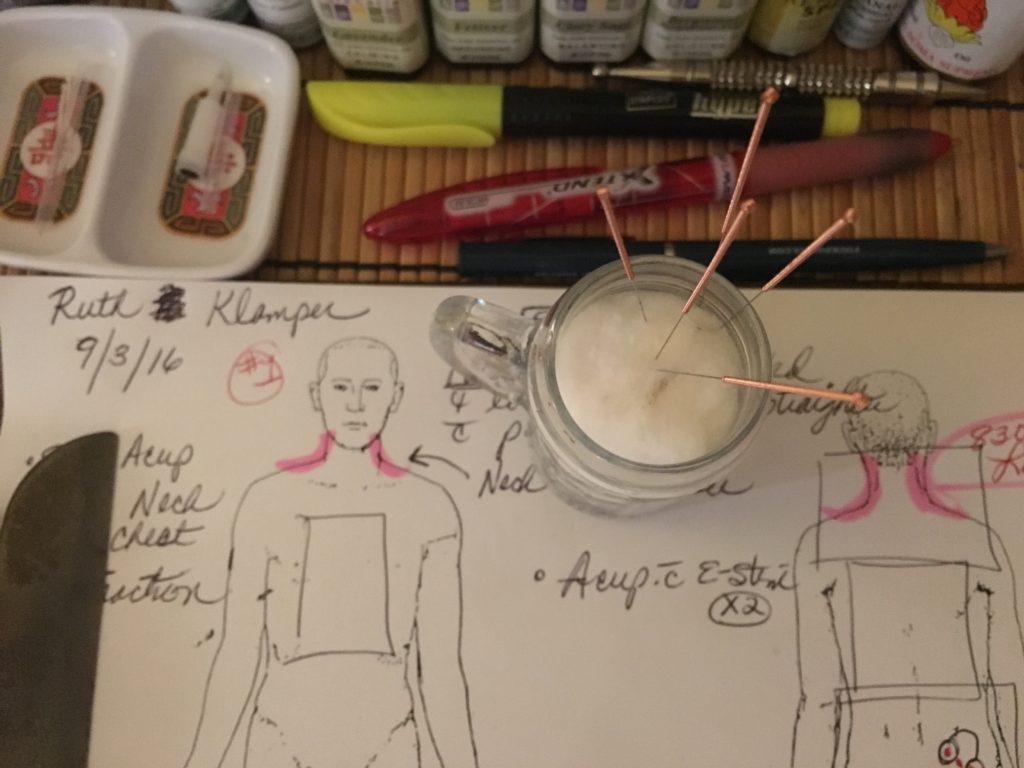
After completing my intake record, and thoroughly examining my tongue, Becky and I discussed what treatments she would be doing on me. Massage therapy, cold laser (low level light) therapy, acupuncture with electro-stimulation (say what?), and, last but definitely not least, cupping.
“Cupping can be done in conjunction with many other procedures,” says Becky. “Because everyone is unique, there isn’t a cookie cutter recipe or ‘one-size-fits-all’ approach.”
After I peeled off my clothes and hopped onto the warm table, Becky re-entered the room and treatment commenced. She placed heated steam packs on my abdomen and chest, as well as a silk eye pillow over my eyes. She began by placing three small acupuncture needles in my ears to promote relaxation. I couldn’t help but give myself a mental ‘high-five’ for officially joining the acupuncture club.
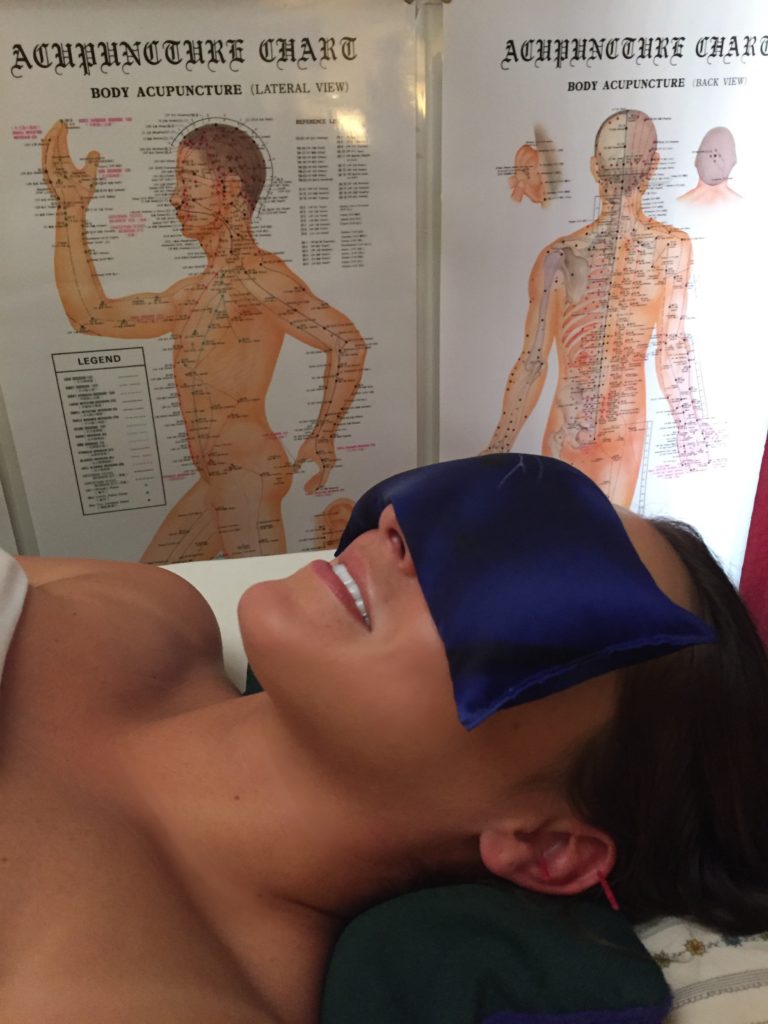
Next, she encouraged me to find my breath and focus on it. She truly helped me relax and seize the moment, something I’m rarely able to do with an active infant at home. She reminded me that this treatment was about me and how important it is to take time for myself.
She began massage therapy and it took everything I had to not fall asleep on her table. I felt like I was floating on clouds. Did I mention she used what felt like fairy dust on my feet, shoulders, and neck throughout the duration of the massage. I later inquired what the soft, airy, soothing potion was. Becky explained that she often uses baby powder when giving massages, instead of greasy lotions and oils, so that her patient’s skin isn’t oily and slick.
For the next portion of my treatment she asked me to flip over onto my stomach so my backside was up. We discussed my hip and back pain and determined that my hip could greatly benefit from acupuncture with electro-stimulation. Becky carefully mapped out needle placement on my derriere and, within minutes, inserted the needles into the precise points. Then, she pulled out what looked like miniature jumper cables that were plugged into the electro-stimulation unit, similar to a TENS unit, which would soon be clipped onto several needles already inserted in my hip area muscles. The cables would essentially connect two needles and pulse currents through them, relaxing the muscle and surrounding tissues.
While my hip muscles continued to pulse, Becky prepped the skin, using coconut oil, on my upper and lower back for cupping. As I quickly learned, cupping can be performed in conjunction with other procedures.
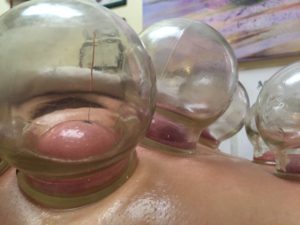
Becky explains, “An acupuncture needle is sometimes inserted and then a glass cupping jar is placed over it, looking like a needle sitting inside of a glass domed igloo! So acupuncture may be done before, during or after cupping. There might be acupuncture done on other areas of the body while cups are on other parts. The treatment plan is always determined case by case.”
Becky disconnected the electro-stim from the needles and proceeded to place a heated cup over the top of three of them. I could see the reflection of the flame in the wood floor, so I squeezed my eyes as tight as I could and prepared myself for the sensation I was about to encounter. I could feel the heat of the cup getting closer and closer to my body. And, just like that, the first cup was placed. First observation: My skin felt really tight. I definitely wouldn’t describe the sensation as painful. Instead, it felt more like skin being pinched or suctioned.
Cups were placed one after another on my back. To do the cupping treatment, Becky held a hemostat (clamp) that clamped on a cotton ball (prepared with alcohol). The alcohol-soaked cotton ball was then lit, creating the flame needed for fire cupping. She then very briefly inserted her hemostat (with the flaming cotton ball) into the glass cup which created a vacuum inside the cup as the flame removed the oxygen from the cup. Repeating this technique for each cup, Becky then quickly placed each glass cup strategically on the tight muscles along the length of my back on both sides of my spine.
Once all cups were in place, Becky encouraged me to relax, breathe, and rest. She covered my back with a blanket and exited the room for a short time. I took that opportunity to focus on my breathing and attempt to come to terms with what had just happened to my body. The treatment didn’t hurt. It all happened so fast. My back was starting to feel numb, to the point of me not even feeling the cups on my back anymore. I started to wonder if the cups were going to fall off. Did I have more bulbs on me than a Christmas tree? I began pondering what my back would look like once the cups were removed.
“The unknown is what we are fearful about,” says Becky. “I really want to demystify cupping and acupuncture because these therapies have not been experienced by many people who are still too fearful and think these treatments are going to be scary and painful. When actually, they can give a lot of pain relief and can be very relaxing.”
Becky re-entered her office a few minutes later. She inquired how I was doing. Then, after a few minutes, it was time to remove the cups and treat the skin with refreshing oils. As the cups were removed quickly one-by-one, I felt an exorbitant sense of physical relief. It was as if my skin was breathing and all tension had subsided. The discomfort I was having in my back, prior to treatment, was miraculously gone.
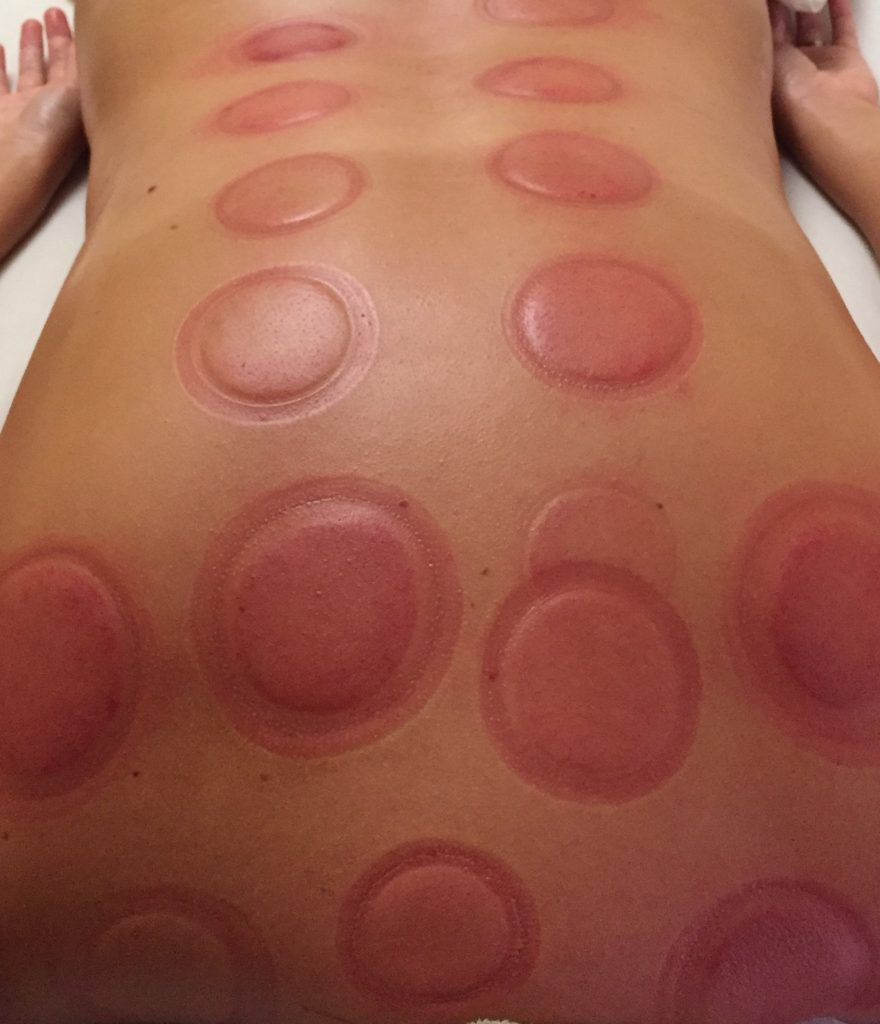
Becky explained I would see different variations of color in the cupping marks. The areas that were severe ‘problem areas’ would show deeper reddish-purple marks than areas that weren’t as troublesome.
Overall, my experience with cupping was eye-opening. Going into the treatment I had my own agenda. But, after meeting with Becky and listening to her holistic approach to healthcare, I quickly realized that I’ve been taking better care of my car than my body.
“If a check engine light goes on in your car, you take your car to the shop, you don’t cover up the warning light with a piece of duct tape. So, why is it that people are taking better care of their automobiles than their bodies?” asks Becky. “It’s important that you make your health a priority. If we have preventive healthcare and maintaining whole body healthcare, it’s important that you have a healthy diet, eat regularly, drink plenty of water, get plenty of sleep and exercise, and do things that you enjoy and have fun doing. There is so much tension and stress that’s held in the body. Having a healthy life requires balance.”
Read more of my interview with Becky below:
How long have you been practicing on the island?
“I’ve lived on the island for the past 13 years and after 22 years of having a practice in Mission Valley, I moved my practice here three years ago. I very much enjoy living just a couple blocks away from my office on Orange Avenue.”
What type of training was required for you to do this type of procedure?
“Many classroom hours of anatomy, physiology, and pathology, in addition to learning oriental medicine theory and acupuncture, was the foundation for all students before doing any kind of procedure on a patient’s body . And then, there were many supervised hours in the classroom, which included hands-on practice and, of course, the college clinic had a supervised intern program as well. I have a Masters degree in Traditional Oriental Medicine. It wasn’t required of me, but, I elected to take the national exam, so I am also nationally board certified in acupuncture. I’ve always continued my education since graduating in 1993 and becoming a licensed acupuncturist, and have been trained in many other holistic therapies, including Ayurvedic Medicine and Zhu’s Neuro Scalp Acupuncture. And yes, I have a very eclectic practice with many different types of therapies that I can offer my patients. Each person is unique, so I am pleased to offer something that’s feels best for each individual. Not everything is ‘best’ for everyone. My practice is definitely not a ‘one-size-fits-all’. Treatment plans are uniquely designed for each person.”
What five words best describe the aesthetic of your treatment room?
“Safe, calm, relaxing, nurturing, and healing.”
What are the most significant health benefits of cupping?
“There isn’t a ‘most significant’ health benefit. I would say the benefits are going to be different for each patient. For example: You may be experiencing a lot of pain in your back, so the most significant benefit for you would be pain relief. For someone who suffers from constipation, the most significant health benefit for them would probably be to have things moving and relief of constipation and cramping. So, health benefits really depend on the individual and what their needs are. However, overall, I would say from experience, most people would say the benefit is pain relief. Whether it’s from neck, shoulders, back, legs, abdomen, or headaches, pain relief is often the most common benefit. Cupping can be used for relieving swelling, inflammation, muscle spasms, cramping, tightness & tension from stress, sciatica, sports injuries, etc.”
“What many people don’t realize is that cupping can also be used to tonify in cases where there is a deficiency rather than an excess condition. It is all in the kind of of technique that is used. You don’t need to do the intense level of very strong cupping that we saw done on the Olympic athletes. There are so many different techniques that are used and have been used for ages.”
Are there any risks involved with cupping?
“There are risks involved with any procedure, if they are done incorrectly. That’s why it’s important to go to someone who has been trained properly. Licensed professionals will know where not to do cupping and when not to do it. For example: around the heart. Someone who has a pace-maker shouldn’t have cupping done around their heart. If you are pregnant you shouldn’t have cupping done on your lower abdomen. A person taking blood thinners or someone with very thin, delicate skin would not be candidates for cupping. These are some examples. Cupping is not dangerous when a properly trained and educated person is doing it.”
What is one thing people probably don’t know about cupping?
“Cupping can be used for a variety of things and can be used all over the body. Also, people don’t realize how calming a treatment can be. They see the marks on the Olympic athletes and think that they are bruises and that the treatment must have been painful. It’s quite the opposite. You aren’t “bruising” the person because you aren’t causing blunt trauma to an area. The treatment area, if there is a mark, it shouldn’t hurt after the cupping treatment.”
We saw a lot of athletes with cupping marks on their bodies during the Olympic games. Who else, other than Olympic athletes, benefits from cupping?
“The truthful answer is: EVERYBODY. If you have someone who is trained doing this properly, it can really be done on just about anyone.”
Is there anyone who shouldn’t do cupping?
“Yes. People who aren’t trained in cupping. This doesn’t mean the University of Youtube! For example, I wouldn’t want someone with no training and no understanding of the underlying anatomy wanting to “fix my tight neck muscles” and then proceed to put cups all over my neck including the carotid artery! Only people who have gone to school and are educated in all aspects of cupping and are properly trained in cupping should do it.”
How often should someone schedule a treatment?
“That depends. In general, if someone has extensive cupping done, you wouldn’t be doing cupping again on that same area until all of the cupping marks are completely gone. I would usually wait to schedule another session with the person at least one week later, unless I was planning to do cupping on other areas of the body or doing other types of therapies other that cupping.”
Is cupping done in conjunction with other procedures and, if so, how do you determine a treatment plan?
“It may be done in conjunction with other treatment. Acupuncture needles can be inside of cups, as you [Ruth] experienced. Acupuncture may be beforehand, maybe after. There might be acupuncture done in other areas of the body while cups are on other parts. The treatment plan is determined case by case.”
What would you say is your approach to maintaining whole body healthcare?
“Treat the root… Not just the branch.”
“Find the root cause of the problem. Don’t just put a band-aid on it for a temporary ‘quick fix’ or mask the body’s ‘pain warning light’ with a pain blocking pill. Then we’re just covering up the car engine warning light with duct tape!”
“There is nothing mysterious. I would say… living everything in moderation and balance. If we practice preventive healthcare for maintaining whole body health, I’d say it’s important that you have a healthy diet, eat regularly, drink plenty of water, get plenty of sleep and exercise, spend time in nature to reconnect with yourself and allow the mind to disconnect from the busy digital modern world and simply experience quiet peacefulness. When the mind becomes calm, then the body also begins to relax and release its held tensions. Rebalancing can then happen. And last, but not least, truly do things that you really enjoy and have fun doing! Having a healthy life requires balance.”
What would you tell someone who is hesitant, scared, or anxious of undergoing a cupping treatment?
“The unknown is what we are most fearful about. So, come in and we’ll talk and demystify all of those fears and anxieties about the unknown. I always spend a good deal of time talking with all my new patients and especially those who may be anxious in any way about trying something new.
“I love to teach and to explain to my patients what a treatment is like and to do show-and-tell, I really enjoy it. If they are nervous or unsure about trying cupping or acupuncture, I usually do a demonstration on myself. For example, with acupuncture, I’ll put a needle in me, and if they are open and want to just try it, I can put one in them too, and then they have had the experience for themselves and can then decide whether or not they are ready and wanting that particular treatment technique that day, or to perhaps try it next time or another day. My wish is to demystify cupping and acupuncture for everyone. People come in here and they think that treatments are going to be scary and they don’t know that actually the various treatments can provide a lot of pain relief and can be very relaxing.”
To learn more about cupping and alternative treatment options, contact Frazier at:
Email: [email protected]
Text/Call: (858) 204-9768




